- Wartime Alliance
- Axis Defeat Both strategy and resources are included for 2 and 3.
- Allied Victory
- Impact of the war on British Civilians
- Impact of the war on German Civilians
- Perspectives
- Historiography
Note 1: This unit does not have the same requirements like that in Paper II – Causes and Effects of 20th-century wars. It is more likely that you compare and contrast a European war with one in Asia for that part of the course.
Note 2: For this unit, it is recommended that you study guerrilla warfare on the Eastern Front. This is so you are able to compare and contrast with the Chinese Civil War if guerrilla warfare is an examination question.
The Second World War in Europe had many similarities to the First World War. The countries involved were largely the same, although some had different names by 1939. Moreover, the fighting took place in some similar places too, on the western front, the armies almost refought First World War battles. However, there were huge differences too. The air war was far more significant. It was much more a war of movement because of the mechanised forces. And casualties were far higher, especially due to the fighting on the eastern front.
1. Wartime Alliance
Axis Powers
1936 Rome-Berlin Axis. This established the friendship between Italy and Germany. Italy felt it was now safer thinking she had German support and Germany felt her southern border was now more secure.
1936 Anti-Comintern Pact signed by Japan and Germany. This was aimed at limiting the power of communism but specifically the USSR. Hitler also wanted to help Japan limit the power of the Chinese communists in their war against the nationalists.
1939 Nazi-Soviet Pact. Germany signed this to avoid a two-front war and the Soviet Union gained control over the Baltic countries. Furthermore, they agreed to divide Poland between them and promised to avoid any aggression between the two countries.
1939 Pact of Steel. This brought Germany and Italy together, economically, politically and militarily. They would assist each other in war if one of them requested.
1940 Tripartite Pact. This was an agreement concluded by Germany, Italy, and Japan on September 27, 1940, one year after the start of World War II. It created a defence alliance between the countries and was largely intended to deter the United States from entering the conflict.
1940 Hungary, Romania and Finland all joined the Tripartite Pact. All three were involved in the war against the USSR. Hungary wanted lands which were taken away from her in the Treaty of Trianon. Romania, which had valuable oil supplies, joined the Pact because it feared the USSR (Germany could act as a guarantor for her security) and she was able to retake Moldavia from Russia. Finland joined the Pact because of Soviet aggression, being attacked in November 1939.
1941 Bulgaria was promised lands in the Balkans when it joined the Tripartite Pact. She declared war on the western powers but not on the USSR. Bulgaria withdrew from the Pact in 1944 but was invaded by the USSR in the same year.
Tasks
- To run a war economy, a country needs trading partners or colonies. How do the following maps show you why Germany chose their allies?

2. What were the advantages of the Axis alliance?
3. What were the disadvantages of the Axis alliance?
Allied Powers
The Allied Powers in the Second World War initially comprised the British and French empires and Poland. Other powers agreed to join the alliance in the following years.
1940 Norway, Denmark, Belgium, Netherlands, Greece and Luxembourg.
1941 Yugoslavia, USSR (after being attacked by Germany in June), USA, China and several countries from Central America.
Many more countries entered the war on the Allied side but none had a major impact. However, Italy switched sides in 1943 and other former Axis powers, Bulgaria and Romania (both 1944) and Hungary (1945) did so too.
The leading Allied powers held conferences during the Second World War to discuss strategies to defeat the Axis. These were:
1943 Cairo Conference. Roosevelt (USA), Churchill (UK) and Jiang Jieshi (China) discussed how to defeat Japan. Stalin (USSR) did not attend because he had signed a non-aggression pact with Japan in 1941 and if they knew he discussed their defeat with Jiang, it could cause conflict between the two.
1943 Tehran Conference. Roosevelt, Stalin and Churchill discussed how and when to open a ‘Second Front’ on mainland Europe to force Germany to move resources and manpower away from the eastern front. They also discussed the future of post-war Europe although could not agree on what would happen to Poland and other east European states.
1945 Yalta Conference. Roosevelt, Stalin and Churchill finalised the strategy to defeat Germany. They also continued to discuss the future of postwar Europe after German was defeated. The country would be divided into four zones and the USA, USSR, UK and France would each control one of them until Germany was in a position to govern itself again.
1945 Potsdam Conference. In July, Truman (replacing Roosevelt as he had passed away through illness), Attlee (replacing Churchill as he lost an election) and Stalin discussed what should happen to Germany and Europe now that the war in Europe was over. There were many disagreements (leading to the Cold War) but did make progress in discussing the strategy to defeat Japan (which surrendered in August).
Tasks
1. The Soviet invasion of Finland in December 1939, in addition to their attack on Poland in September 1939, gave Britain and France a difficult decision. Do they declare war on Germany’s ally? Why did they choose not to? Was this the right decision?
2. What were the advantages of the Allied alliance?
3. What were the disadvantages of the Allied alliance?
4. Which events triggered the changes in the alliances?
a. USA
b. Italy
c. Finland
d. Hungary
e. Romania
f. USSR
2. Axis Defeat
The following presentation was by Andrew Roberts, a key military historian.
Strategy
- Invading the USSR led to the Axis Powers fighting a two-front war (Britain was not defeated). Some of the biggest battles in world history took place on the eastern front and the Axis lost them all.
- The invasion of the USSR led to the growth of Nazis’ racial policies being used. They sought lebensraum in Eastern Europe but because of their racist ideology brought the local populations against them. Without this, the Axis could have incorporated these millions of people into their empire as workers, not slaves. Many in the USSR were resentful of Stalin’s rule (Ukraine is a good example because of Holodomor) so initially welcomed the Nazis. However, Hitler did not take advantage of this because of his racism.
- Italy’s invasion of Greece in 1941 failed. As a result, Germany had to help out her ally as this delayed the invasion of the USSR. The Wehrmacht was not fully prepared for winter fighting so arguably if the invasion was earlier, they could have won before it arrived.
- Being allied with Japan did not necessarily mean Germany had to declare war on the USA after Pearl Harbor. But they did and this allowed huge amounts of manpower and resources to be directed at the Axis war machine. Hitler underestimated the military power which the USA could eventually produce (although it was not very strong in 1941).
- For balance, Hitler declared war on the USA because he wanted to maintain the siege of Britain with his U-boats. By making America an enemy, he could attack all shipping in the Atlantic.
- Hitler relied on his own understanding of war to conduct battles and campaigns rather than listen to the military experts. This was especially the case after the successful invasion of France in 1940, Hitler overruled his commanders to launch the operation and its success made him think he knew better. He also prevented them, especially later in the war, from taking any strategic retreats (so resources and manpower were taken or killed by the enemy). Moreover, he sacked commanders and this disrupted the stability of an army.
- The German military strategy (labelled Blitzkrieg in 1940 by Time magazine) was designed for short campaigns. The Wehrmacht’s strategy did not have sufficient mechanised forces or supplies to maintain long campaigns such as that on the eastern front. To know more about blitzkrieg, watch the video below.
- Hitler did not give sufficient resources to the U-boats. Economic warfare helped the allies win the First World War and he used the U-boats to conduct this strategy himself during the Second World War. The commander of this campaign (Admiral Doenitz) argued that if he was given more resources, he would have defeated Britain.
U-Boats and the Second World War
- The German decision to begin the Blitz eventually backfired. The Luftwaffe bombed British cities to destroy the war machine (supplies, weapons, food) and the morale of the people. But it only gave Britain sympathy from countries such as the US and when they launched their own bombing raids onto Germany, they were far more destructive. Hundreds of thousands of people died because of raids on Cologne, Hamburg and Dresden. They also hit the German war machine, affecting the supply of materials to the frontline armies. Importantly, artillery pieces such as the 88mm guns, which were useful against Soviet tanks, were used to defend German cities instead, weakening the effectiveness of their armies.
- The Luftwaffe changed its strategy during the Battle of Britain to bomb cities rather than airfields. This gave the Royal Air Force time to replenish losses and use bases from which their fighters could defend the country against the German bombers.
- The Axis did not work together as much as the Allies, Germany did not collaborate with Japan. This was partly due to racial ideology.
- Nazi Germany decided to pursue the ‘Final Solution’ in 1942 (although had begun murdering Jewish and other minority civilians in 1941). The Holocaust took valuable resources and manpower away from fighting the war. And the killing of seven million people deprived the Nazi war machine of both labour and intellect (brain drain).
Resources and the Economy
- The Axis Powers did not have sufficient oil to maintain a long war. Romania had oil but not the same quantities as the Allies.
- The size of the Axis populations compared poorly with the Allies so they were less likely to win a long war.
- With the exception of Germany and Japan, the economies of the Axis powers were weak.
- Germany’s allies were generally weak. An example was Italy, the troops were not properly equipped for this type of was and had poor morale and discipline as a result. They lost in Libya, Egypt and even Albania.
3. Allied Victory
The following video is fairly easy to understand and useful for studying when nearing an examination.
Strategy
- Successful in the Battle of Britain (arguably a failure of Axis strategy, see above). This provided a base to invade mainland Europe in the future and made the Axis fight a two-front war.
- British evacuation from Dunkirk in 1940. The rescue of 330 000 troops (called Operation Dynamo) from northern France allowed Britain to rebuild and train much larger armed forces.
- The Allies broke the secret codes of the Axis with their enigma machine. They were able to see where future attacks were planned and ensure their forces were sufficiently defended as a result.
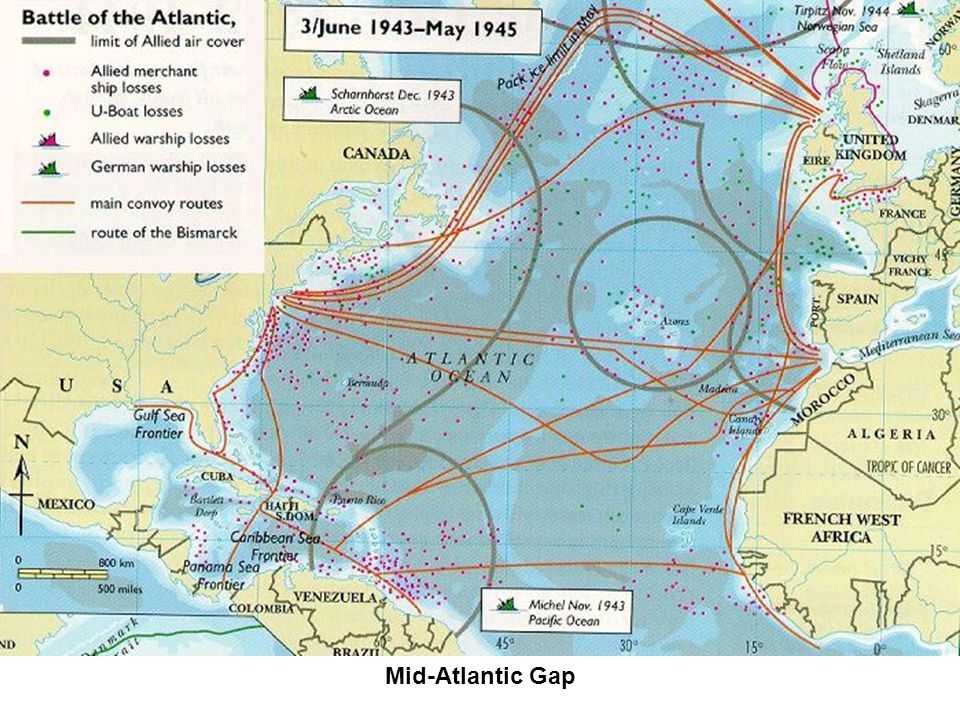
- The Allies worked together far more effectively than the Axis. They established a prime strategy, to defeat ‘Germany First‘, with a command structure – one person in charge, General Eisenhower. This concentrated both resources and manpower into one theatre and produced a material advantage in the theatre of Europe.
- The Red Army developed a strategy, maskirovka, or deception, to defeat the Axis Powers. It also developed an echeloned defence to prevent Germany’s blitzkrieg strategy being successful (initially developed in the Deep Battle strategy). Blitzkrieg was meant to punch a hole through the enemy and then turn around to attack them in the rear. The Soviet echeloned defence was very deep, with layers of forces (anti-aircraft, anti-artillery, anti-tank) in place, so that a German breakthrough of the first echelon had to deal with a second, a third, a fourth etc. As these could be one-hundred miles or more in length, there would not be any attack in the rear.
- Strategic bombing, or the Bomber Offensive, conducted by the British and American air forces, disrupted the Axis capacity to wage war. For five years, the Royal Air Force (USAAF from 1942) bombed German cities with the purpose of destroying infrastructure, factories and civilian morale. This, in turn, helped the Allied morale (their propaganda exaggerated the destruction) and forced their enemy to use both men and weapons to defend the country – they could have been fighting the USSR instead.
Resources and the Economy
- Allegedly from a German commander – ‘ 1 German tank was worth 4 US tanks. The problem was they always sent 5’. I cannot find the origins of the quote but it gives a good idea of the Allied advantage during the Second World War. For example, when the US reached full capacity they could produce 70 000 tanks and 120 000 aircraft.
- The US policy of Lend-Lease gave countries such as Britain and the USSR huge amounts of war materiel. These proved important in the theatres of North Africa and Eastern Europe respectively.
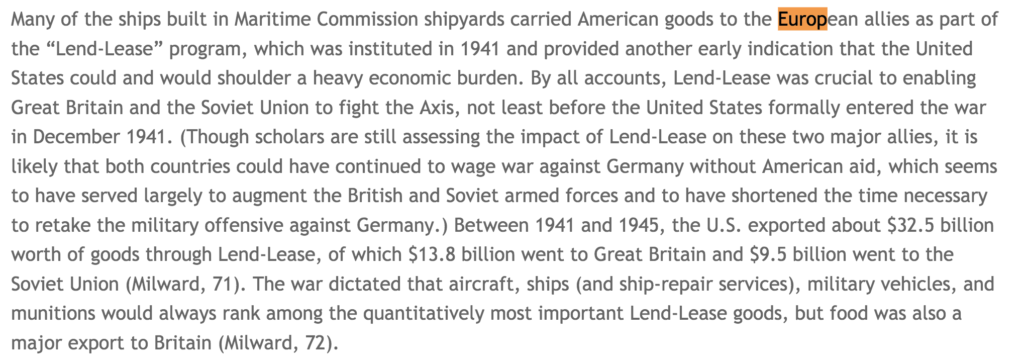
- The USSR physically moved their industrial capacity from the west of the country to the east. This ensured they could continue producing war materiel and prevent the Axis from taking their resources.
- Stalin’s autocratic and dictatorial rule forced Soviet civilians to contribute to the war effort. This meant that they could eventually outproduce the Axis forces.
- By 1945, the British and US navies dominated the seas in Europe but there were times when this was not so. Their efforts to defeat both the German U-boat and surface fleet threat allowed Britain to remain supplied with food and resources throughout the war.
- The British Empire had a huge number of people to fight for them (debatable if they had a choice).
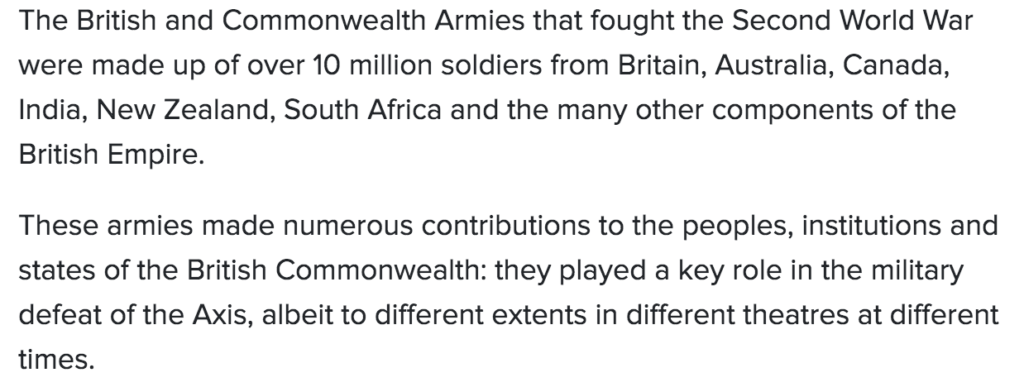
Guerrilla Warfare
Soviet and Russians had a history of fighting the invader, in both Napoleon’s invasion in 1812 and the fight against the White forces during the Russian Civil War. Therefore, fighting a guerrilla war was important to the Soviet Union, it even being discussed by Marshal Tukachevsky (a key architect of the Deep Battle strategy – see above) in the 1930s.
- Half a million people fought as partisans for the USSR during the Second World War.
- Their initial activities in 1941 were uncoordinated and unsuccessful. They lacked training and experience.
- After the failure of the Axis forces to take Moscow in December 1941, the Soviet government began to organise these forces more. Morale was high after the debacle of the early months of the war and people more likely to join and fight. This is a key similarity to the Chinese Communist guerrillas.
- The Communist Party, not the Army, was in command of the partisans. Marshal Voroshilov became the Commander-in-Chief and departments organised into intelligence, communications, operations and others. Orders were issued from Moscow and filtered down to the districts. Although the proportion of Party members declined as the war drew on, they still had the power to influence the commander of the unit.
- The partisans had groups (of between 300-800) attached to armies and those who operated in enemy territory. Most were not volunteers and the majority were from the peasant class. There were also former collaborators (who worked with the Germans) who improved the effectiveness of the partisan groups, and those who had been drafted into the partisan units. Moreover, as the war progressed ex-Red Army soldiers became members and the units further improved.
- Women made up only 2% – 5% of the partisans and their roles were scouts, radio operators and cooks.
- The majority of partisan weapons were automatic rifles. However, occasionally they had access to artillery and even tanks.
- Living conditions were hard, just like it was for most guerrilla fighters. Access to food was difficult as the Axis soldiers had taken much of it and their own scorched earth policy had ruined much of the supplies.
- To alleviate this situation, the Red Air Force was used to drop supplies behind enemy lines. For example, during the summer of 1944, the Soviet aircraft had dropped sufficient mines for the partisans that they were able to place 9600 of them in German-held territory. Supplying these groups became increasingly effective owing to the US programme of providing aid to their allies.
- The Red Air Force was also capable of coordinating with partisan groups when attacking the enemy.
- Strategy: they disrupted and destroyed enemy communication and logistics networks and even assassinated General Wilhelm Kube, the officer in charge of Belorussia. A maid who worked at his residence was able to smuggle a bomb past the guards and hide it under Kube’s bed.
- Sabotaging the enemy rail network prevented their forces from getting to the required positions for battle (destroying their communications). This was evident at the Battle of Kursk in 1943, the largest tank battle in history. Prior to the conflict, over 100,000 partisans in the occupied territories of Soviet Ukraine, Byelorussia, areas near Smolensk, Oryol and Leningrad began to blow up railways, trains, bridges and stations. From Russia Beyond
- Units generally opted to survive the war rather than follow all orders from above. Consequently, they would falsify reports and select safer missions.
- The Soviet government used partisans in their propaganda to highlight what was possible.
- Discipline was extremely harsh although not dissimilar to the Red Army. Death sentences were passed for drunkenness, looting, sleeping on duty and mistreating the local population.
- In addition to ambushes, partisans also gathered intelligence for future operations of the Red Army.
- They also administered those areas which the Moscow government could not. They were the local police and judiciary, handing out severe punishments for the simplest of crimes.
- The Soviet Partisans are regarded as the most successful of the guerrillas in the European theatre. These groups were well-supplied, equipped and trained. Arguably, the size of the country made it easier for aircraft to supply them.
- A key reason why they were successful was because they were facing a conventional army which had little experience in fighting against guerrillas. The German armed forces had fought in the Spanish Civil War but guerrilla warfare was only prevalent after 1939 (the Marquis).
- The morale of the Axis soldier would be affected because there would be little respite, you could be attacked from any side.

https://warfarehistorynetwork.com/2016/12/16/scourge-of-the-russian-partisans/ https://www.youtube.com/watch?v=_Dax3rZ9Tj4 https://www.youtube.com/watch?v=Ens-3319CzI&has_verified=1
4. Impact of the war on British Civilians
Human Cost
Although you should focus on the two countries stated above, the following table and video give you an idea of how the various countries suffered during the Second World War. When making judgements for Britain or Germany, you can put them in the context of the other countries.

British Civilians
Britain was not alone in fighting this war, its empire fought alongside them in different parts of the world (North Africa, Western Europe, Asia). Although she was on the winning side again, the war had a huge cost on the country.
- Britain began to lose her empire. India gained independence in 1947 and this event continues to be controversial to this day.
- After the First World War, the British government promised a ‘land fit for heroes‘. This did not happen for the majority of the working people (General Strike, Depression). Consequently, when a general election took place in April 1945, the ruling Conservative Party (under Churchill) suffered a huge defeat to the Labour Party; they promised social changes such as the Welfare State. The highly influential Beveridge Report was one of the reasons people wanted social change. Although both political parties accepted it, it was Labour who was more trusted to implement the policy. The Beveridge Report was so successful it changed British politics and was even dropped by aircraft onto the German population to demoralise them.
- During the war, the British people faced the blitz. Although there were a few examples of aerial bombing during the First World War, it was nothing on the scale of 1940 to 1945. Consequently, parts of many British cities (for example Coventry, London, Birmingham, Liverpool and Bristol) were destroyed. This had a negative impact on the economy, infrastructure and ability to recover after the war.
- Rationing was introduced in 1940 because of the decreasing number of supplies entering Britain (German U-Boats attacking British merchant shipping). This page explains how people only received an allocation of foodstuffs each week.
- A serious issue in all countries was the civilian impact of the war. This was especially true for children. If parents knew they were safe or being looked after, they would contribute to the war effort much more. Consequently, the British government organised the evacuation of children from urban to rural areas. This policy began almost immediately when war broke out but was reintroduced more forcefully when the blitz began in 1940. This page explains it in more detail.
- The British government had predicted aerial bombing before 1939 (having seen the destruction of Guernica in the Spanish Civil War) so built fighters to combat the bombers and planned bomb shelters. Civilians also expected bombing and some made their own plans. For example, some of the wealthier families decided to send their children abroad. However, this proved disastrous very early in the war when the ship Athenia was sunk.
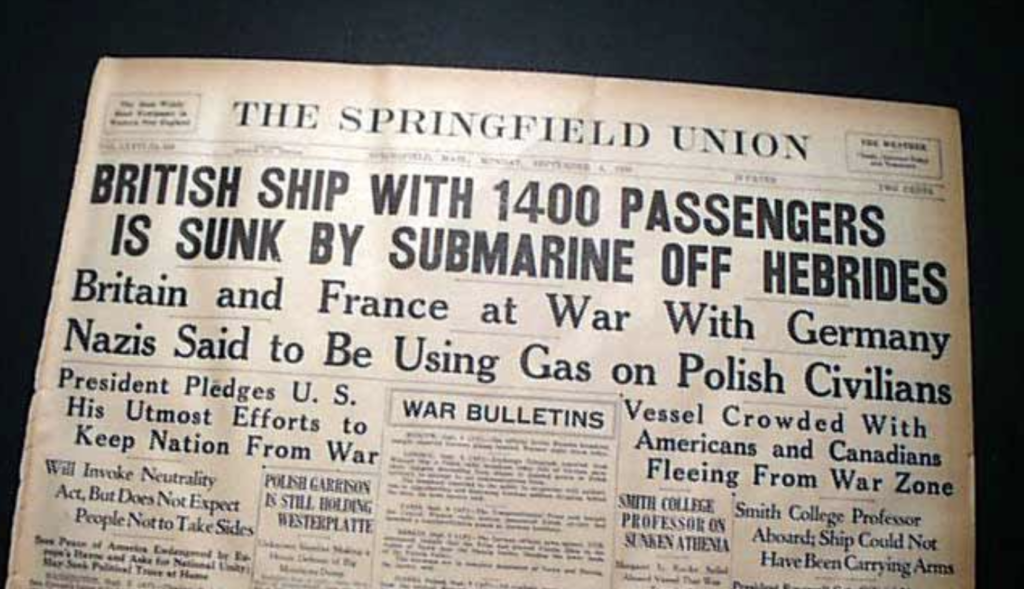
This article explains the sinking from the point of view of one of the survivors.
- As with all countries during the war, the British civilians were fed a constant stream of propaganda aiming to maintain their morale. Successes were exaggerated and losses were understated. Secrecy was also made into a huge issue, it stopped people from talking casually about the war and made them feel part of the war effort.
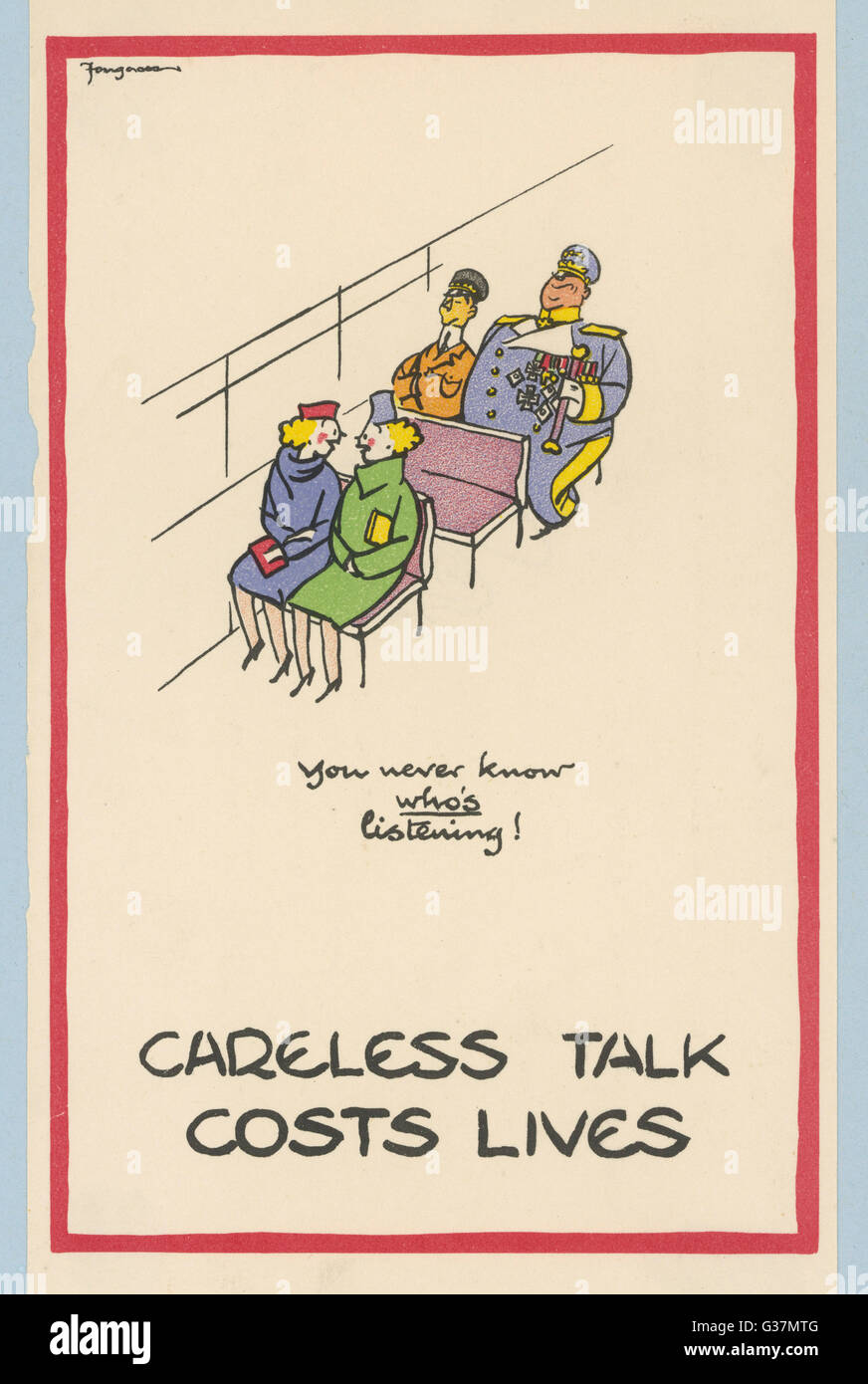
BBC Bitesize – Social Impact on Britain
THE EVACUATED CHILDREN OF THE SECOND WORLD WAR
Persuading the people: British propaganda in the Second World War
The British people also ‘endured’ German propaganda in the form of Lord Haw Haw. An example of his propaganda is below.
Lord Haw-Haw: popularity of wartime Nazi propagandist made the BBC up its game
5. Impact of the war on German Civilians
- In response to the blitz, the British Royal Air Force (RAF) conducted their own bombing campaign (the Bomber Offensive) on Germany. This became far more destructive than the blitz ever was, culminating in huge firestorms in Cologne, Hamburg and Dresden. In 1942, the United States Army Air Forces (USAAF) also took part in the bombing campaign over Germany.
- From the BBC – ‘Over the next 3 years: 61 German cities, with a combined population of 25 million, were attacked; 3.6 million homes were destroyed; 7.5 million people were made homeless; 300,000 – 400,000 Germans were killed in the raids; and 800,000 people were wounded. However, German industrial production continued to increase until mid-1944.’
- Another consequence of the bombing campaign was the growing number of refugees. People would flee the Ruhr area during the early stages of the bombing (it was within range of aircraft but with the development of technology eventually all of the country was a possible target) and in 1945 escape the oncoming Soviets (see the video below) by going west.
- The people also had to endure rationing as a result of naval losses. Consumer goods became increasingly limited because of the war and the Nazi economic policy of autarky. For example, meat imports suffered because they were at war with the US, a key supplier throughout the world.
- The economy suffered because of many reasons but a key factor was the shortage of both unskilled and skilled workers. 13.7 million men served in the armed forces during the war. Although women entered the workforce, it was not enough to make up for the shortfall. Furthermore, the ‘undesirables‘ were sent to concentration camps or fled abroad. These people could have made a positive contribution to the economy (slave labour was used extensively for Eastern Europeans, Jews and others but it was not enough).
- Propaganda was a key factor in the Nazis remaining in power from 1933. Similar to the British, successes were exaggerated and losses either ignored or understated. The latter became increasingly difficult to hide as the war drew on.
- Opposition to Hitler grew during the war but the apparatus in place to deter it was generally successful. The threat of the Gestapo and concentration camps were factors in keeping the population in check. However, as you may have studied in ‘Authoritarian States’ the Nazis remained in power because of both the support and acquiescence of the German people. Consequently, the people continued to fight the Bolshevik threat to their nation and rally behind Hitler. After all, he had led Germany to both foreign and military policy success until 1940.
- The example of opposition, the Edelweiss Pirates, the Swing Kids and White Rose, were small in number. However, there were acts against Hitler, the most famous being the July Plot where elements of the Army attempted to assassinate him. This failed and led to the execution of the organisers. Furthermore, the Gestapo may have used this incident as an excuse to arrest other possible opponents and rivals.
- The debate about how much the German population knew of the Holocaust continues but arguably those who lived near the camps or the transit stations were aware of the policy and were ‘persuaded’ not to intervene as a result.
Homefront Propaganda in Germany and the U.S.A.
Life in Germany during World War Two
- The video below shows how the people of Germany suffered in 1945 arguably more than any other year. The Soviet soldiers, who had borne the brunt of the war in Europe since 1941 and faced the Nazi ideological warfare at its worst, took their revenge out on the civilian population.
BBC – Savage Peace, Atrocities Against Germany
Perspectives
Allies Won
Jeremy Black writes extensively on the Second World War and argues in this article that the Allies outfought the Axis soldiers, it was not merely resources alone which determined the outcome of the war. The Axis fighting quality was undoubtedly more powerful in 1939 and 1940 but this began to change in 1941. Black argues that the Allies reached this level and even beyond. They learned how to coordinated their forces (artillery, airpower, infantry and mechanised forces) effectively to defeat the Axis powers. The Allied forces were able to learn from their mistakes from the early years of the war, Hitler being in charge of the Axis prevented this from happening.
Another key historian on the Second World War and author of Why the Allies Won, Richard Overy, agrees with Jeremy Black in this BBC article. The Red Army learned from its mistakes quickly, mimicking the German armoured columns in how to fight this fluid type of war. However, Overy explains that Soviet and US industrial production allowed the Red Army to conduct this fighting. Germany underestimated both the resistance of this army (despite huge losses in 1941 and 1942) and US armaments production. Therefore, in declaring war on these two powers, Germany made two huge strategic mistakes. Finally, Overy argues that Allied air power proved decisive. It maintained the morale of the Allies through the difficult early years and was able to disrupt the enemy war effort with their bombing.
From Richard Overy’s article,

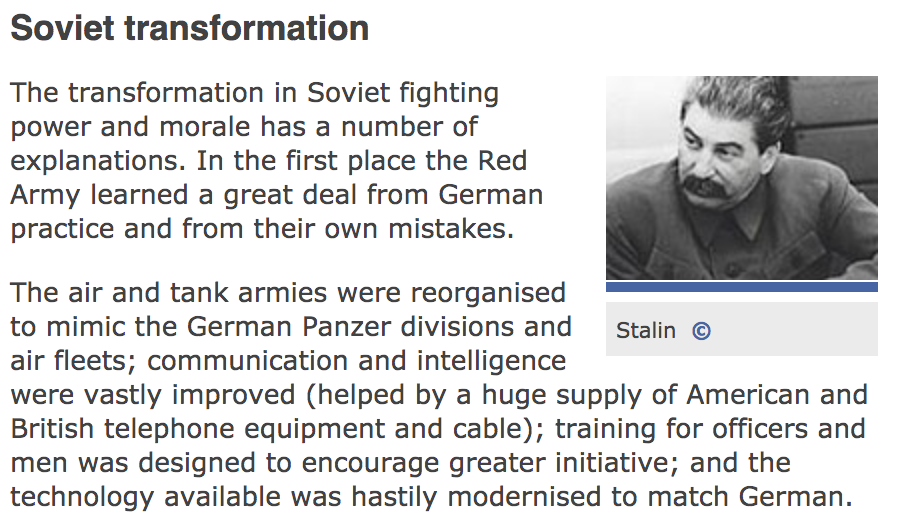
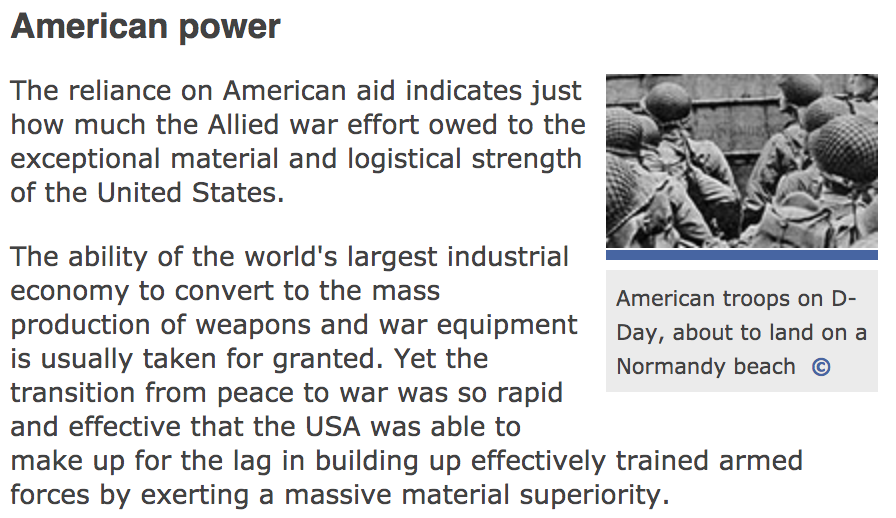
Philips-Payson O’Brien argues that the Soviet role in defeating Germany has been exaggerated. Instead, Allied sea and air power were responsible for winning the Second World War.
Axis Lost
- Richard Overy explains above that the Allies won the war but he also criticises Germany for their strategies. He argues that the Allied Bomber Offensive forced the German air force, the Luftwaffe, to defend their cities with fighters and artillery. These weapons reduced the war-fighting capacity if the army and navy. The bombing also affected the German economy and its capacity to produce the tools for war. Furthermore, Hitler directed his military to solve the problems of the Allied bombing offensive and its solution, the VI and VII rockets, took time and resources away from other, possibly more important strategies.
- Stephen J. Lee argues that Hitler was partly responsible for the successful war years of 1939 to 1941 but culpable for the failures in the second half of the war. He did not learn from his failures in the first half, unlike Stalin who learned a great deal.
- Andrew Roberts, in his documentary above (2. Axis Defeat) argues that Hitler did not put sufficient resources into his u-boats. If there were, Germany could have strangled Britain and forced her out of the war. Moreover, he explains that Hitler made several strategic errors during the war. These are all connected to his ideology of Fuhrerprinzip where he did not make errors. As Germany was bombed by the British in 1940, he forced the change of strategy during the Battle of Britain to begin the Blitz. And his policy towards achieving lebensraum, and eradicating both Bolshevism and the Jewry were not strategic but also ideological.
- Roberts adds that, unlike Stalin, Hitler did not adhere to the advice given by his generals. This led to the Germany Army not being able to conduct strategic retreats as much as they wanted to. Moreover, many commanders were moved around geographically or were removed from their positions. Hitler was a virtual military commander from 1941 onwards rather than a political leader. However, his lack of training and experience in military affairs meant that he was making poor decisions.
- Finally, Hitler declared war on the USA when he did not need to. He believed US entry into the Second World War, as a result of the surprise attack by Japan on Pearl Harbor, meant that his navy (u-boats) could operate more freely in the Atlantic Ocean. Moreover, he believed their army would fight against Japan in the Pacific. This strategy proved disastrous in the long-term as Roosevelt’s government opted for ‘Germany First’, meaning that the majority of their military power would be directed against Hitler.
- In the article below, Roberts also explains that Hitler’s invasion of the Soviet Union was a key factor in the Axis losing the war and who was responsible for strategic errors.
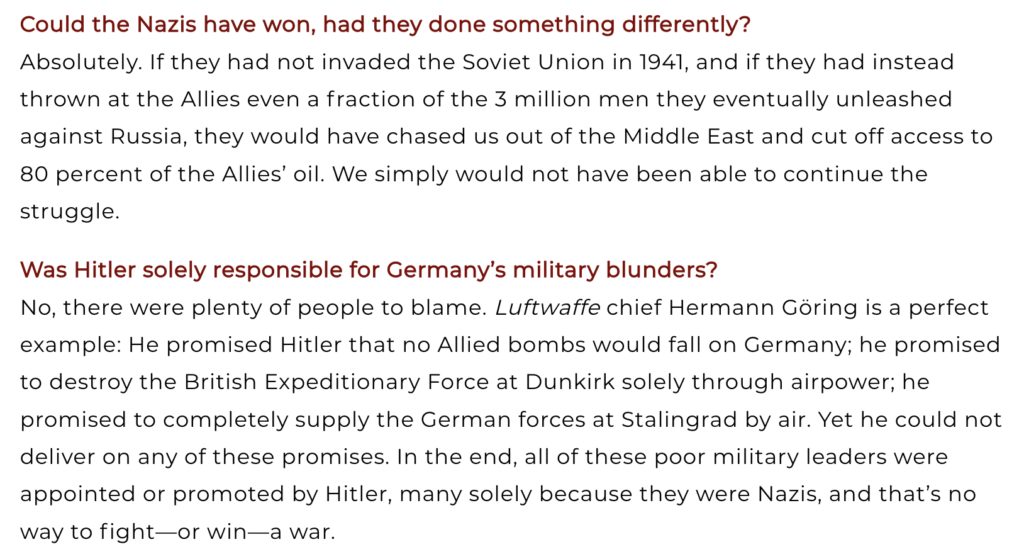
Historiography
If you believe history is written by the victors then the Second World War changes this maxim. As a result of the Cold War, Western history explained how the United States and Great Britain won the Second World War. The USSR was not a major force, historians being able to identify their alliance with Nazi Germany, a poor performance against Finland and their reliance on largely US aid (lend-lease) to fight on the eastern front.
However, to demonstrate balance within this blog…the Soviet historians were also influenced by the Cold War. Their studies of the Second World War referred to the ‘Great Patriotic War‘, the conflict between the USSR and Germany. This began in 1941 and ended with the Soviets taking Berlin in April 1945. This history conveniently forgets the years 1939 to 1941 when the USSR attacked and invaded Poland, the Baltic countries and Finland. Moreover, if you visit Russia today, there are commemorations across the country which remember the Great Patriotic War.
Obviously, this all changed when the Soviet Union fell in 1991. Archives were opened in the 1990s and western historians, no longer influenced by the Cold War, could access these and bring much-needed balance to the study of the Second World War.
- The political leaders after the Second World War had lived and even fought two huge conflicts. One can argue that the west learned from history in that unconditional surrender was sought from Germany rather than an armistice (November 1918). This would stop another ‘dolchstoss’. Furthermore, as the League of Nations had failed to keep the peace, a stronger United Nations and North Atlantic Trade Organisation (NATO) were developed.
